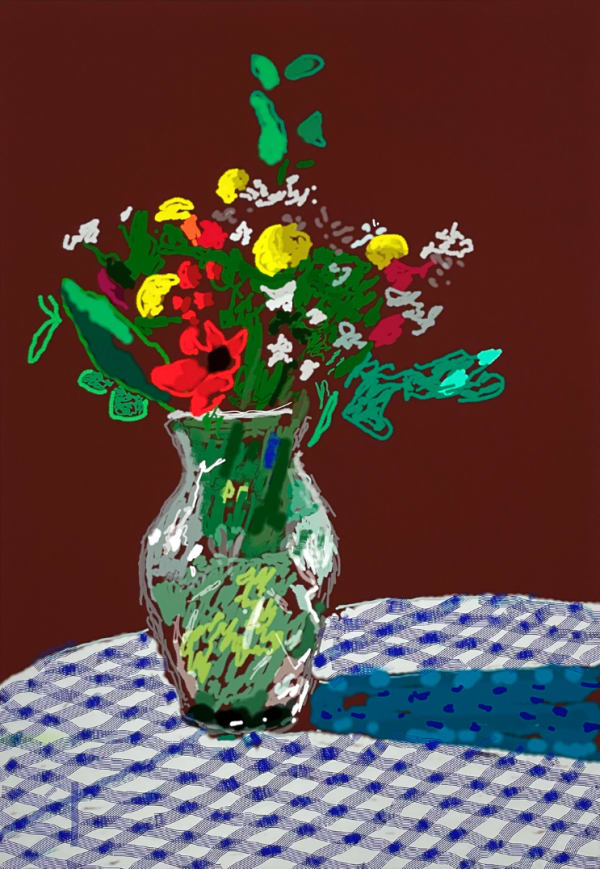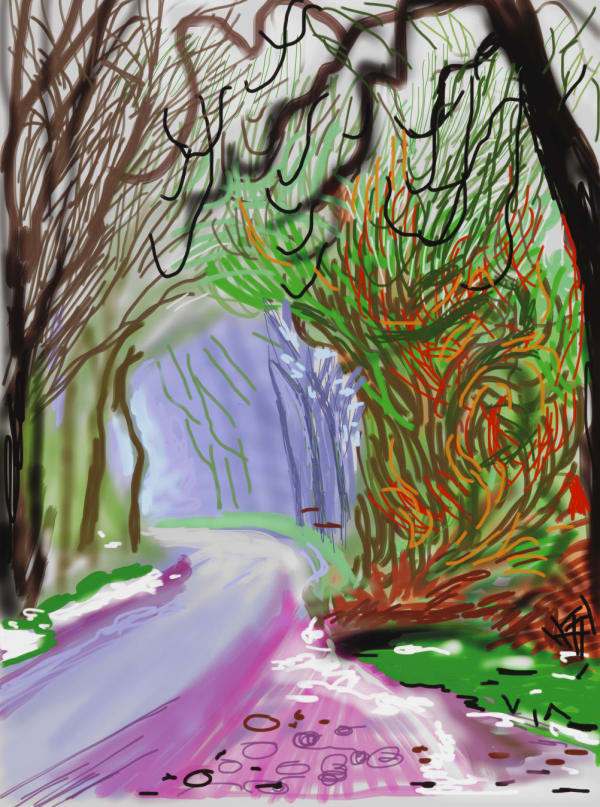David Hockney’s prolific career has spanned over six decades during which he has continually redefined his approach to art, refusing to be confined by medium, style, or technology. Hockney’s evolution is not only a narrative of personal and artistic growth, but also a mirror of broader changes in art, society, and technology.
Early Years: From Royal College to Pop Art (1950s–1960s)
Hockney’s formal training began at the Bradford School of Art and culminated at the Royal College of Art in London, where he studied alongside artists like R.B. Kitaj and Peter Blake. In these formative years, Hockney experimented with expressionism and abstraction, influenced by contemporaries like Francis Bacon and Pablo Picasso. However, it was during the early 1960s that he aligned himself with the burgeoning British Pop Art movement.
This period was marked by playful, text-based paintings such as *We Two Boys Together Clinging* (1961), inspired by the poetry of Walt Whitman and layered with coded references to his own sexuality. These early works were bold, graphic, and conceptual—testing the boundaries of figuration, narrative, and identity in a society where homosexuality was still criminalized in the UK.
The California Years: Light, Space, and the Swimming Pool (1964–1970s)
In 1964, Hockney relocated to Los Angeles, a move that would profoundly alter his palette, subject matter, and perspective. The West Coast presented a utopia of light and leisure, which he captured in now-iconic paintings like *A Bigger Splash* (1967) and *Portrait of an Artist (Pool with Two Figures)* (1972). These works celebrated Southern California’s architecture, bodies, and pools, rendering them in flat planes of color and stylized realism.
Hockney began to use acrylic paint during this time, embracing its fast-drying properties to render the reflective surfaces of water and glass. His compositions became more cinematic and spatially structured. He also developed a fascination with double portraits, painting friends and lovers in intimate domestic settings—Mr and Mrs Clark and Percy (1970–71) being among the most notable.
Polaroids and Photocollages: Fragmented Vision (1980s)
By the 1980s, Hockney had begun to experiment with photography in ways that pushed the limits of traditional image-making. Dissatisfied with the single-point perspective of conventional photographs, he assembled hundreds of Polaroid snapshots into composite images he called “joiners.” These works, like *Pearblossom Hwy., 11–18 April 1986, #2*, offered a cubist reinterpretation of space and time—inviting the viewer to experience multiple viewpoints simultaneously.
This period also reflected Hockney’s deepening engagement with optical theory and art history. He began writing and lecturing about the limitations of perspective in Western art, ideas that would culminate in his controversial book *Secret Knowledge* (2001), in which he argued that Old Masters may have used optical devices like the camera obscura to achieve realism.
Return to Yorkshire: The Landscape Reimagined (1997–2009)
Following the death of his close friend and curator Jonathan Silver in the late 1990s, Hockney returned to his native Yorkshire. This homecoming sparked a new chapter in his career, rooted in the English countryside. Hockney began painting en plein air, often working on location to capture the rolling hills, winding roads, and seasonal shifts of Bridlington and the Wolds.
Using oils and watercolors, Hockney created monumental landscapes—some of them composed of dozens of panels—that invited viewers into immersive panoramas. Works like Bigger Trees Near Warter (2007), which measured over 40 feet wide, demonstrated both technical mastery and a meditative reverence for nature.
This phase reasserted Hockney as a traditional painter, yet it also reinforced his commitment to challenging how we see. He used multiple canvases to force viewers to piece together a scene, thereby destabilizing linear perspective even in the most classical of formats.
Embracing the Digital: iPads, iPhones, and New Ways of Drawing (2009–Present)
Hockney has long been a technological pioneer. In the 1980s he experimented with the fax machine and early computer software; by 2009, he was drawing daily on his iPhone using the Brushes app. This digital curiosity led to some of his most celebrated innovations of the 2010s: iPad drawings.
The Yosemite Suite (2010–11), The Arrival of Spring in Woldgate, East Yorkshire (2011), and later, iPhone and iPad drawings of flowers and interior scenes demonstrated Hockney’s mastery of digital media. These works were printed at large scale or presented on LED screens, drawing attention to both their painterly quality and the immediacy of their creation.
Unlike traditional painting, the iPad allowed Hockney to work quickly and intuitively, often sending images to friends within minutes of finishing them. This turned art into an ephemeral, almost conversational practice, while still rooted in the fundamentals of color, line, and form.
Theatrical Design, Opera, and Spatial Experiments
Beyond the canvas and screen, Hockney has also made significant contributions to stage design. Since the 1970s, he has designed sets and costumes for operas such as Turandot, The Rake’s Progress, and Tristan und Isolde. His understanding of theatrical space and layered depth informs much of his two-dimensional work and speaks to his ongoing concern with perception.
His operatic work also intersects with his landscape compositions. Both are deeply concerned with how space is constructed and perceived—whether through the flat pictorial plane or the three-dimensional stage.
Late Style: Bigger Perspectives and Global Recognition
In recent years, Hockney has continued to challenge convention. His 2021 exhibition at the Royal Academy, The Arrival of Spring, Normandy, 2020, comprised works drawn on an iPad during lockdown. These luminous depictions of trees, blossom, and light captured the universal search for hope during a time of isolation.
He has also turned to immersive installations, such as Bigger & Closer (not smaller & further away), a 2023 digital experience at Lightroom in London. Combining animations, voiceovers, and large-scale projections, it reaffirmed Hockney’s place at the forefront of artistic innovation.
Despite being in his late eighties, Hockney remains a restless creator. He paints daily in his Normandy studio, often rising at dawn, and continues to explore how art can shape the way we see the world.
David Hockney’s evolution is not a linear trajectory but a series of creative revolutions. From bold Pop canvases and sun-drenched pools to fragmented photographs, immersive landscapes, and digital blossoms, Hockney has repeatedly reinvented both his style and his tools.
What unites his diverse output is a consistent fascination with perception—how we view the world and how art can stretch, clarify, or distort that vision. His career exemplifies a lifelong curiosity and a refusal to settle, making him not only a master of his craft but a living embodiment of artistic exploration.
In an art world that often prizes novelty or tradition, Hockney defies categorization. His work invites us to look again, and then again, and to recognize that seeing is never a passive act—it’s a way of knowing, remembering, and feeling. Discover signed David Hockney prints for sale and contact our galleries for further information. Looking to sell? We can help. Find out how to sell David Hockney prints with our expert team.













